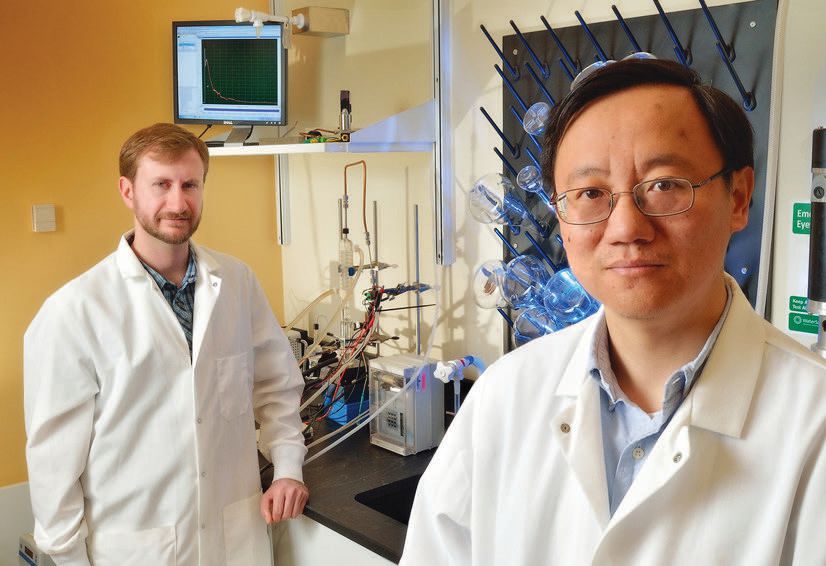Hydrogen production from low-cost biofuel
Dr. Neil Canter, Contributing Editor | TLT Tech Beat July 2015
An alternative strategy more efficiently produces hydrogen from biomass.
KEY CONCEPTS
•
Biomass, the most widely available fuel for producing hydrogen globally, contains a high percentage of the fermentable sugars glucose and xylose.
•
In vitro metabolic engineering has been used to efficiently convert these sugars into hydrogen through the development of an enzymatic pathway.
•
Adjustment of the substrate, enzyme concentrations and the reaction conditions led to an increase in hydrogen production to 54 mmoles per liter hour.
INTEREST IN HYDROGEN FUEL-CELL CARS IS GROWING AS TOYOTA introduced a hydrogen-powered vehicle in Japan in December 2014. The vehicle will be available in Europe and North America in the second half of 2015.
For hydrogen-powered vehicles to establish a significant presence in the automotive industry, several negative concerns will have to be overcome. One issue is that lack of sufficient infrastructure in the form of hydrogen refueling stations. In a previous TLT article, the development of a transient-flow facility to evaluate flow meters used in dispensing hydrogen as a fuel is discussed (
1).
A second issue is finding a cost-effective process for generating hydrogen. Dr. Percival Zhang, professor in the department of biological systems engineering at Virginia Tech in Blacksburg, Va., discusses some of the currently available options. He says, “Thermochemical production options such as electrolysis of water or the use of solar energy are expensive and suffer from low conversions.”
Currently, hydrogen is produced mainly through the use of hydrocarbon fuels. But researchers are also looking to improve conversions through the use of enzymes. In a previous TLT article, the first-ever conversion of a hydrocarbon into useful energy was achieved with an enzyme cascade (
2). The researchers converted the kerosene-based jet fuel known as JP-8 at room temperature into alcohols and then into aldehydes through the use of a biofuel cell. Power densities as high as 3 milliwatts per square centimeter (mW/cm
2) were found with the biofuel cell.
Zhang says, “The ideal fuel to use in producing hydrogen is biomass, which is more abundant and more evenly distributed globally than hydrocarbon fuels. Based on data obtained in 2011, over one billion tons of dry biomass could be harvested in the USA by 2050.”
The components present in biomass that can best be converted to hydrogen are the fermentable sugars present in plant cell walls. Over 90% of these sugars consist of glucose (C6) and xylose (C5).
Zhang says, “Current methods for converting biomass to hydrogen suffer from low yields. One mole of glucose can be converted to four moles of hydrogen, but the yield is typically 30%, which means that two-thirds of the chemical energy used is wasted.”
Using the enzymatic pathway within a microorganism is the logical first choice in developing an efficient way to produce hydrogen. But the process has a number of disadvantages. Zhang says, “In whole-cell biosystems, the priority for the living organism is to duplicate itself, not to produce a substance desired by researchers. Other difficulties with this approach are the need to transport the desired substance across a cell membrane and the restrictions on varying reaction conditions to optimize yields.”
The need exists for an alternative strategy to more efficiently produce hydrogen from biomass. Such an approach has now been developed.
IN VITRO METABOLIC ENGINEERING
Zhang and his colleagues, including lead author, Dr. Joe Rollin (
see Figure 3), have developed a very efficient enzymatic pathway for converting glucose and xylose simultaneously to hydrogen using a technique known as in vitro metabolic engineering. Zhang says, “In-vitro metabolic engineering involves constructing an enzymatic pathway outside of a living cell to conduct complex biochemical reactions. It provides us with a good deal of flexibility to maximize the reaction rates of each step in the process without being restricted by the microorganism.”
 Figure 3. Lead author Dr. Joe Rollin (left) and Dr. Percival Zhang led a team of researchers that have developed a very efficient enzymatic pathway for converting the fermentable sugars, glucose and xylose into hydrogen. (Figure courtesy of Virginia Tech.)
Figure 3. Lead author Dr. Joe Rollin (left) and Dr. Percival Zhang led a team of researchers that have developed a very efficient enzymatic pathway for converting the fermentable sugars, glucose and xylose into hydrogen. (Figure courtesy of Virginia Tech.)
The researchers are able to achieve this result using a relatively low-cost and widely available biomass feedstock, the husks and stalks of corn plants. Cellulose and xylan (the main component of hemicellulose) represent the two main sources of biomass sugars.
A four-module pathway was designed that can theoretically lead to yields of 12 moles of hydrogen per mole of glucose and 10 moles of hydrogen per mole of xylose. Zhang says, “Our process is able to simultaneously convert glucose and xylose, which previously have been difficult to co-react and also to separate.”
The pathway directly converts cellulose into hydrogen and converts xylose into a glucose derivative that can then be plugged into the hydrogen generation pathway. Promising results were initially found that led the researchers to develop a kinetic enzymatic model to maximize hydrogen formation. Zhang says, “We used typical chemical engineering to change reaction conditions and then validated predictions from the modeling through experimentation.”
The process is run under mild conditions that include atmospheric pressure and a relatively low temperature between 50 C-60 C. Hydrogen can be readily isolated from the aqueous process because it is a gas.
The result is that hydrogen formation is increased three-fold to 32 mmoles of hydrogen per liter hour. Further adjustment of the substrate, enzyme concentrations and the reaction conditions increases production to 54 mmoles of hydrogen per liter hour.
Zhang believes that the productivity of this process is comparable to that of industrial biogas and hydrogen production. He says, “We have now validated this enzymatic pathway on a small scale, but now we are looking to increase production of a hydrogen to a liter scale and then ultimately to a commercial scale. In addition, we are also seeking to conduct the enzymatic reaction in one reaction vessel.”
Additional information can be found in a recent article (
3) or by contacting Zhang at
ypzhang@vt.edu.
REFERENCES
1.
Canter, N. (2014), “Testing meters used to dispense hydrogen fuel,” TLT,
70 (10), pp. 15-16.
2.
Canter, N. (2015), “Room temperature biofuel cell,” TLT,
71 (2), pp. 14-15.
3.
Rollin, J., Campo, J., Myung, S., Sun, F., You, C., Bakovic, A., Castro, R., Chandrayan, S., Wu, C., Adams, M., Senger, R. and Zhang. Y-H. (2015), “High-yield hydrogen production from biomass by in vitro metabolic engineering: Mixed sugars coutilization and kinetic modeling,”
Proceedings National Academy of Sciences,
112 (16), pp. 4964-4969.
 Neil Canter heads his own consulting company, Chemical Solutions, in Willow Grove, Pa. Ideas for Tech Beat can be submitted to him at neilcanter@comcast.net
Neil Canter heads his own consulting company, Chemical Solutions, in Willow Grove, Pa. Ideas for Tech Beat can be submitted to him at neilcanter@comcast.net.